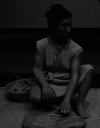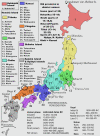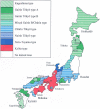Japan considered from the hypothesis of farmer/language spread
- PMID: 37588377
- PMCID: PMC10427481
- DOI: 10.1017/ehs.2020.7
Japan considered from the hypothesis of farmer/language spread
Abstract
Formally, the Farming/Language Dispersal hypothesis as applied to Japan relates to the introduction of agriculture and spread of the Japanese language (between ca. 500 BC-AD 800). We review current data from genetics, archaeology, and linguistics in relation to this hypothesis. However, evidence bases for these disciplines are drawn from different periods. Genetic data have primarily been sampled from present-day Japanese and prehistoric Jōmon peoples (14,000-300 BC), preceding the introduction of rice agriculture. The best archaeological evidence for agriculture comes from western Japan during the Yayoi period (ca. 900 BC-AD 250), but little is known about northeastern Japan, which is a focal point here. And despite considerable hypothesizing about prehistoric language, the spread of historic languages/ dialects through the islands is more accessible but difficult to relate to prehistory. Though the lack of Yayoi skeletal material available for DNA analysis greatly inhibits direct study of how the pre-agricultural Jōmon peoples interacted with rice agriculturalists, our review of Jōmon genetics sets the stage for further research into their relationships. Modern linguistic research plays an unexpected role in bringing Izumo (Shimane Prefecture) and the Japan Sea coast into consideration in the populating of northeastern Honshu by agriculturalists beyond the Kantō region.
Keywords: Japanese language; Jōmon genetics; Mumun–Yayoi migrations; Yayoi agriculture; language/farming hypothesis.
© The Author(s) 2020.
Conflict of interest statement
None of the authors have conflicts of interest to declare.
Figures






Similar articles
-
Patterns of systemic stress during the agricultural transition in prehistoric Japan.Am J Phys Anthropol. 2010 May;142(1):112-24. doi: 10.1002/ajpa.21208. Am J Phys Anthropol. 2010. PMID: 19953616
-
Dental caries prevalence as evidence for agriculture and subsistence variation during the Yayoi period in prehistoric Japan: biocultural interpretations of an economy in transition.Am J Phys Anthropol. 2007 Dec;134(4):501-12. doi: 10.1002/ajpa.20694. Am J Phys Anthropol. 2007. PMID: 17935154
-
Variation in limb proportions between Jomon foragers and Yayoi agriculturalists from prehistoric Japan.Am J Phys Anthropol. 2008 Oct;137(2):164-74. doi: 10.1002/ajpa.20853. Am J Phys Anthropol. 2008. PMID: 18484628
-
Tracing population movements in ancient East Asia through the linguistics and archaeology of textile production.Evol Hum Sci. 2020 Feb 14;2:e5. doi: 10.1017/ehs.2020.4. eCollection 2020. Evol Hum Sci. 2020. PMID: 37588355 Free PMC article. Review.
-
[Cranial nonmetric variation of Yayoi people in the Kyushu District].Kaibogaku Zasshi. 2000 Apr;75(2):241-9. Kaibogaku Zasshi. 2000. PMID: 10824516 Review. Japanese.
Cited by
-
Archaeolinguistic evidence for the farming/language dispersal of Koreanic.Evol Hum Sci. 2020 Oct 14;2:e52. doi: 10.1017/ehs.2020.49. eCollection 2020. Evol Hum Sci. 2020. PMID: 37588366 Free PMC article. Review.
-
Infectious diseases may have arrested the southward advance of microblades in Upper Palaeolithic East Asia.Proc Biol Sci. 2023 Aug 30;290(2005):20231262. doi: 10.1098/rspb.2023.1262. Epub 2023 Aug 30. Proc Biol Sci. 2023. PMID: 37644833 Free PMC article.
-
Bayesian analyses of direct radiocarbon dates reveal geographic variations in the rate of rice farming dispersal in prehistoric Japan.Sci Adv. 2022 Sep 23;8(38):eadc9171. doi: 10.1126/sciadv.adc9171. Epub 2022 Sep 21. Sci Adv. 2022. PMID: 36129978 Free PMC article.
-
A Bayesian approach for fitting and comparing demographic growth models of radiocarbon dates: A case study on the Jomon-Yayoi transition in Kyushu (Japan).PLoS One. 2021 May 19;16(5):e0251695. doi: 10.1371/journal.pone.0251695. eCollection 2021. PLoS One. 2021. PMID: 34010349 Free PMC article.
-
About millets and beans, words and genes.Evol Hum Sci. 2020 Jun 15;2:e33. doi: 10.1017/ehs.2020.33. eCollection 2020. Evol Hum Sci. 2020. PMID: 37588388 Free PMC article.
References
-
- Adachi, N., Shinoda, K. I., Umetsu, K., Kitano, T., Matsumura, H., Fujiyama, R., … Tanaka, M. (2011). Mitochondrial DNA analysis of Hokkaido Jomon skeletons: remnants of archaic maternal lineages at the southwestern edge of former Beringia. American Journal of Physical Anthropology, 146(3), 346–360. 10.1002/ajpa.21561 - DOI - PubMed
-
- Baba, S. (2008). Reconsidering the chronology of pottery styles of Mid-Yayoi, and theories of distribution: putting into perspective the possibility of Yayoi Period trading. Bulletin of the National Museum of Japanese History, 145, 101–174 (in Japanese with English title and summary).
-
- Barnes, G. L. (2007). State Formation in Japan: Emergence of a 4th-century Ruling Elite. London: Routledge.
Publication types
LinkOut - more resources
Full Text Sources
